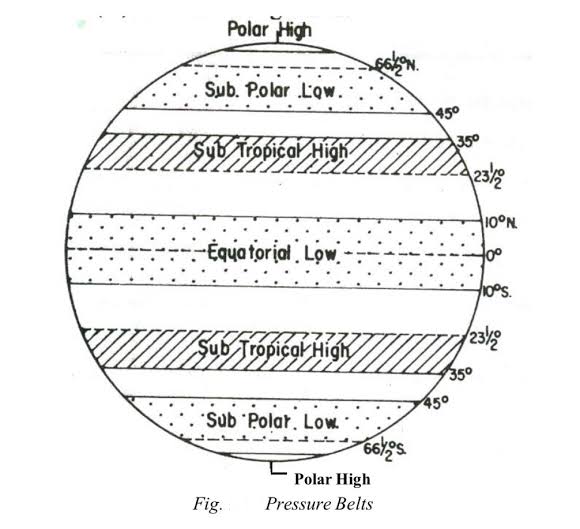03-08-2024 Mains Question Answer
Q. Discuss the development of pressure belts and their distribution over the globe.
Approach:
Introduction: Give a brief introduction of pressure belts.
Main body: Describe each pressure belts and give example too.
Conclusion: Conclude answer summarizing main body and highlight the importance of pressure belts.
Introduction: Pressure belts are areas around the Earth where air pressure is consistently high or low.
There are two types of pressure belts:

- Thermally-induced pressure: These belts are formed due to incoming solar radiation. These include Equatorial Low-Pressure Belt and Polar High-Pressure Belt.
- Dynamically Induced Pressure Belts: These are formed due to the rotation of Earth. These include the Subtropical High-Pressure Belt and Subpolar Low-Pressure Belt.
- Equatorial Low-Pressure Belt: This belt forms at the equator due to intense solar heating, causing air to rise and create low pressure. It results in heavy rainfall, frequent thunderstorms, high humidity, and light, variable winds. Located between 5° North and 5° South latitude, it includes the Intertropical Convergence Zone (ITCZ).
- Polar High-Pressure Belts: These belts form near the poles around 90° North and South latitude where cold temperatures cause air to sink, creating high pressure. They result in cold, dense air, clear skies, dry conditions, and contribute to polar easterlies.
- Subtropical High-Pressure Belts (Horse Latitudes): These belts form around 30° North and South latitudes where cooler air descends from the equator, creating high pressure. They are associated with dry, stable conditions, often resulting in deserts such as the Sahara and the Arabian Desert, and are characterized by clear skies and trade winds.
- Temperate/ Subpolar Low-Pressure Belts: These belts form around 60° North and South latitudes where polar easterlies meet westerlies from subtropical high-pressure areas, creating low pressure. They are known for cyclonic activity, frequent storms, and significant precipitation, and act as a transition between polar and temperate regions.
Seasonal shift and Influence:
- Seasonal shift: Pressure belts shift according to the seasons. During summer, most belts move toward higher latitudes (northward in the Northern Hemisphere and southward in the Southern Hemisphere), while in winter, they shift back toward lower latitudes (southward in the Northern Hemisphere and northward in the Southern Hemisphere).
- Impact on Weather Patterns:
- Pressure belts drive global wind patterns, including trade winds, westerlies, and polar easterlies.
- They influence ocean currents, affecting climate and marine ecosystems.
- They determine precipitation distribution, creating arid conditions in subtropical highs and heavy rainfall in equatorial lows.
- Seasonal shifts of pressure belts impact weather phenomena such as monsoons and tropical cyclones.
Conclusion:
Thus, understanding pressure belts is crucial for predicting weather patterns and comprehending global climate variations.

